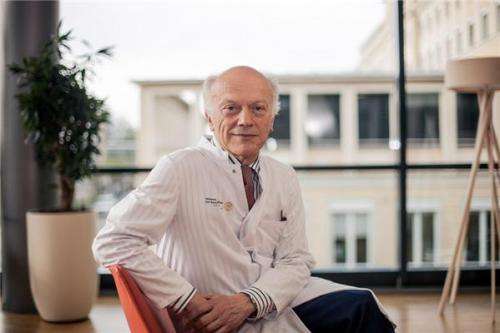A new substance that protects against a dangerous virus, almost without side-effects

Letermovir keeps the ubiquitous Cytomegalovirus in check for weakened immune systems of infected transplant patients.
"In my whole research carrier, I have never seen anything like this in a highly active substance," said Prof. Gerhard Ehninger enthusiastically. The world-renowned Dresdner haematologist, Director of the University Cancer Center (UCC) of the University Clinic Carl Gustav Carus, Dresden, and of the German Stem Cell Donor Registry, was the Coordinating Investigator for a national and international study of the virus blocker letermovir. "Using letermovir, we block the release of replicating virus from the infected diseased cells," explained Prof. Ehninger. At a cellular level, the substance's activity has no effect upon other processes in the body. The substance's almost side-effect free activity could be impressively demonstrated in a controlled, double-blind study: for the first time the placebo affect could be examined here meaning that letermovir is so well tolerated by the weakened body that even fewer side-effects were observed than in patients who received no active treatment.
Today (May 8th 2014), the leading medical journal The New England Journal of Medicine published the ground-breaking results from the German and US research team. The edition's editorial also focused on the work in detail - A sign of the quality and importance of this study.
This substance effectively suppresses cytomegalovirus, also known as human herpes-virus 5. The virus is harmless for healthy people but highly dangerous for the immune-suppressed. "This evolutionarily ancient virus cannot be destroyed within the body," explained Prof. Ehninger. Because of this completely new mechanism of action at a cellular level, the severe side-effects that are seen with current medications are no longer observed. For this reason, patients can be treated with letermovir even on the day of bone marrow transplantation and fight the virus earlier – because of the side-effects caused by current drugs, this was previously only possible on day 30 after transplantation, in order to minimise the risk to the already weakened patient.
A new infection or the reactivation of a pre-existing cytomegalovirus infection can lead to serious problems in an immune-suppressed person. It can lead to CMV-associated inflammation of the bowel with severe diarrhoea, or inflammation of the liver or lungs. For a kidney transplant patient, CMV reactivation could lead to reduced functioning in the transplanted organ or even to loss of the transplant. Indeed, the virus attacks the retina and leads to blindness in 30% of AIDS patients not receiving highly active antiretroviral therapy. Furthermore, infection with cytomegalovirus is also associated with severe liver and lung diseases, hypertension and arteriosclerosis.
The active ingredient, letermovir, which was tested in an extensive clinical study by scientists in Dresden, Houston, Wuppertal, Münster, Würzburg, Iowa, Chicago and Stanford, sponsored by the company AiCuris, acts upon a different site to that used by current anti-virals which act upon the DNA polymerase i.e., upon the replication of the virus DNA by switching off a particular protein. However, this protein is also used in the rest of the body, not only for virus replication. In some cases, this leads to profound side-effects such as supressing the generation of new blood cells or damaging kidney function.
Through this multicentre study it also became apparent that virus testing must be more strongly standardised in line with the World Health Organisation (WHO) guidelines. In a few cases, blood samples taken during study were diagnosed negative for virus replication in the clinic, however in the central study laboratory precisely this reactivation could be shown. A reliable and precise measurement of this parameter is essential for proper and timely treatment with antiviral drug.
More information:
"Letermovir for Cytomegalovirus Prophylaxis in Hematopoietic-Cell Transplantation;" Roy F. Chemaly, M.D., Andrew J. Ullmann, M.D., Susanne Stoelben, M.D., Marie Paule Richard, M.D., Martin Bornhäuser, M.D., Christoph Groth, M.D., Hermann Einsele, M.D., Margarida Silverman, M.D., Kathleen M. Mullane, M.D., Janice Brown, M.D., Horst Nowak, Ph.D., Katrin Kölling, M.Sc., Hans P. Stobernack, D.V.M., Peter Lischka, Ph.D., Holger Zimmermann, Ph.D., Helga Rübsamen-Schaeff, Ph.D., Richard E. Champlin, M.D., and Gerhard Ehninger, M.D., New England Journal of Medicine, May 8, 2014, vol. 370, no. 19:
DOI: 10.1056/NEJMoa1309533

















